Enrich Your Art – Play with Shapes!
This week it’s time to get inspired by shapes and start playing with them!

My dear reader, I guess you follow my blog because you love colors. And yes, isn’t it wonderful to choose, for example, a colored pencil from among several different colors: “Should I pick pink or red, hmm?“
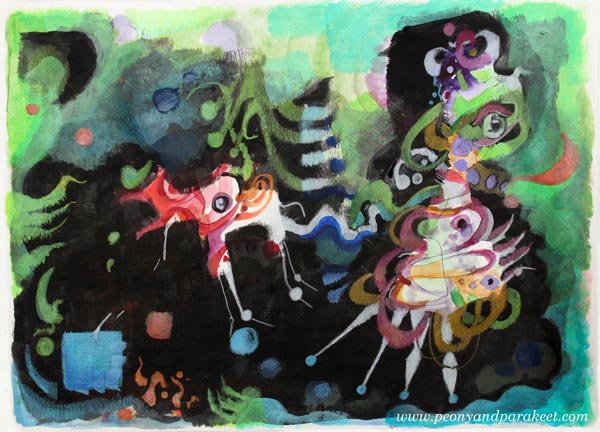
I have a degree in industrial design and maybe that has influenced me to think like this:
A color is a child. A form is a mother.
Colors take spurts freely on the paper while forms set limits. But you can play with form too!

See more about making this in this blog post!
There is no need to turn the mother into an old woman who only sees the reality.
The soul of any shape is abstract and yet, even a simple shape has an expression. It’s fun to draw random shapes and then carefully alter them.

See more about making this in this blog post!
Shapes form a design language that you can constantly enrich. Don’t just draw isolated geometric shapes, but combine them to get more interesting ones!

More about making this in this blog post!
When you have a shape on paper, give your full attention to it.
Art Play with Shapes
Talk to the shape! Interview it!
Don’t ask what she represents, but what kind of world she would like to create around herself.

See more about making this in this blog post!
Ask where she belongs, and what kind of shapes she would like to meet.
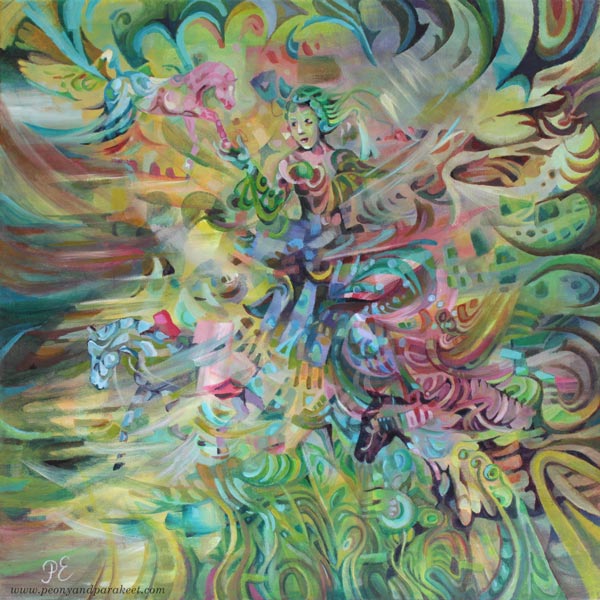
See more about making this in this blog post!
Shapes can take you to imaginative places where realistic and abstract meet. Once you have been traveling for some time, you will notice that the delicacy of art is in the form, and the color – the child – is there only as a spice.

See more about making this in this blog post! – See more pics on the Finnish Art Store Taiko!
Art play with shapes – What are your thoughts? Tell us in the comments!
How to Paint a Fantasy Horse Figurine
This week, we apply art to something different than usual. We use our skills to transform a Schleich horse or other plastic figurine into a fantasy animal.

I have a soft spot for plastic horse collectors, and I follow many of them on Instagram. One of the most inspiring accounts is Lightning Leoo (@lightningleoo). Leo has organized community challenges on Instagram and Discord. I have participated in them a couple of times. Like Leo, most of those who customize collectible miniatures aim to make the animal look more realistic. However, I want to be more playful with colors and ideas.
Step 1 – Choose a Theme and Paint the First Layer
Start by choosing a theme that gives ideas for the coloring. The animal figurine here is a brown Schleich foal and my theme is daffodil. I used acrylic paints to make the legs green, the body yellow, the hoof orange-red, and the tail and the main white – just like the flower!

At this point, the animal doesn’t look nice at all, but that’s ok. The idea is just to cover the original paint and make a simple foundation for the decoration.
Step 2 – Add More Tones and Decorations
After covering the original color with the theme colors, mix more tones of those colors. For example, if you have used one green in the previous step, now mix more green tones – cooler and warmer, darker and lighter, brighter and more muted. Add slight variations of tones on the top of the first color layer so that what used to be one solid color has now a gradient of tones. This makes the color more natural. Note: you can use this technique in any art!

In this project, I created color mixes of all kinds of greens, oranges, yellows, and whites.
At this point, you can also start decorating the figurine and use these color mixes in decorations, eyes,You and other details.

Get ideas for decorations from the theme! I painted small daffodils.
Step 3 – Optional – Add Shadows with Soft Pastels
Soft pastels make the figurine look more real and highlight the best parts. First, scrape them with a sharp blade to get color powder. Use a small brush to spread it where the shadows are, for example, where the leg meets the belly. You can also soften the color changes with pastels.

Attach the powder more permanently by spraying the fixative over it. Notice that after attaching the powder, you can continue with the finishing touches in acrylics!
Step 4 – Take a Fantastic Photo!
We always should take a good photo of the finished work, but with a fantasy horse, it is very rewarding. Find a place where you can fool the eye about the scale and bend down to take a photo a bit upwards.

Another option is to make a gallery set up so that the background is white and the figurine is photographed like a piece of art.

Another Example of a Fantasy Horse Repaint
Here’s a Schleich horse that is bigger than the Daffodil fowl. My theme for this one was peach. The decorations are simple, but there are many tones and lovely gradients.

Making one foot in a different color adds drama and a bigger horse is easier to paint.

It was fun to photograph these two together!

Natural light creates its own effects and makes the fantasy look real.

Horizontal lines in the background make the movement look more real.

Gift Box for Fantasy Horse
These small fantasy horses are great for presents. I gave the fowl to my friend who owns not just a collection of plastic figurines but a real horse too. I found a sturdy box that I had got when ordering paint tubes.

One side had writing on it, but I painted a floral decoration over it.

Creative Play as an Art Form
Playing has always been important to me. When I play, I get ideas that go beyond the ordinary and that combine different fields. In 2020, I even made a painting about the power of play called Steppe Wind.

In the course Magical Inkdom, we draw and decorate paper horses and other animals.

By playing we can enjoy the beauty and be comforted. It’s like we enter the same big hall of art but from a different door. Then when it’s time to get more serious, we have new energy and new power to overcome our fears.
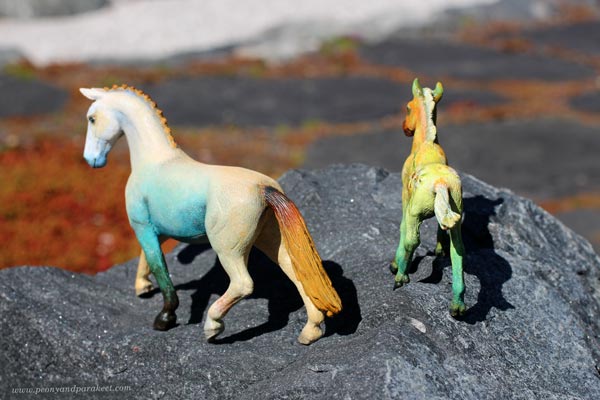
That’s why I want to bring up topics like painting and photographing figurines in this blog.
What do you think?
Beautiful Blog Post
This week is about creating beauty, and I have a beautiful blog post for you.
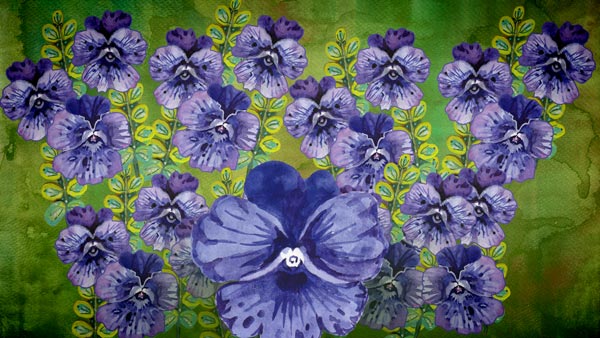
Violets on an Adventure
Ten years ago, an old yard tiling gave us a surprise. Renovating it had been on our to-do list, but there had been other things to do in the house. But we were lucky.

The violets planted in the pot had looked at the tiling and its gaps with completely different eyes. What an opportunity for seeds! So, the following year, we were able to enjoy the glory of flowers in the surprising place.

Creativity is a flower that wants to break free from its pot and get on an adventure. Abundance is allowed and ugliness can enable beauty.

A painting that starts with a few ugly brushstrokes can be decorated
to rich and beautiful.
Beautiful Decodashery

My online class Decodashery is about creating beauty that easily finds its purpose. This kind of art is not just fun to make but perfect for cards and gifts.
Decodashery is one of my personal favorites. The videos are inspiringly colorful and uplifting. You play with the tradition of decorative art and create beauty that people have always found attractive. >> Buy here!
Paint Beautiful Decorative Flowers!
This week, we create stylized beauty. You will see how I painted these beautiful decorative flowers.

Time for Some Happy Art!
At least here in Finland, May-June is a time for parties. There are school graduations and then Midsummer at the end of June, which is celebrated not only by people but by Finnish nature too. Days are long and the deep sleeps during the dark winter are now coming into use. If different art forms had seasons, this uplifting time would be dedicated to decorative painting. Beautiful decorative flowers and other curvy motifs go well with the celebrations.

Decorative art is happy art for most people. Its tradition extends all over the world and it only requires a little sensitivity to beauty from the viewer.
Uplifting Art-Making
Three years ago, when the Corona lockdowns started, I buried myself in decorative painting. I made decorative collages from hand-painted papers and practiced decorative painting techniques.

These curvy forms and lines are still present in my paintings, where decorativeness is mixed with a more dynamic and abstract expression.

Painting in a decorative style is fun. A few thoughtful brushstrokes create beauty, and even a beginner’s work looks great when viewed from a far enough distance. Over time, the brush mark improves and has an effect on all drawing and painting, even handwriting. And it’s the perfect style for cards and gifts!
Starting a Decorative Painting
As I watched the blossoms in apple trees, I felt like painting something small and nice to celebrate the beginning of the blooming season.
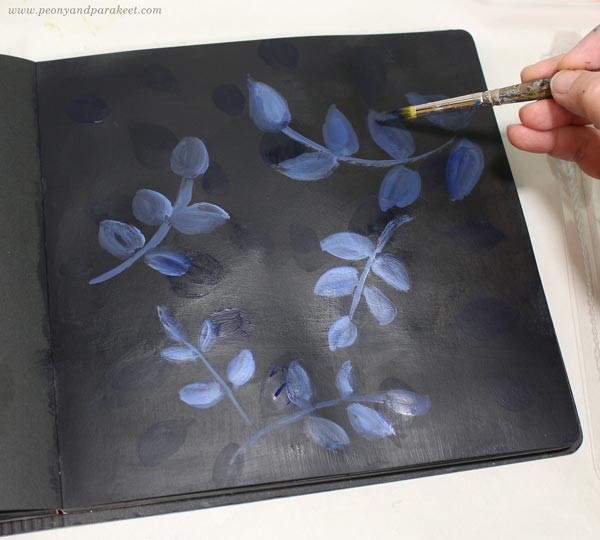
I took out my black Dylusions Creative Journal and acrylic paints and painted the background very dark blue. Then I made leaves on top of each other, and so that they get lighter layer by layer.

At the same time, I watched the videos of my course Decodashery.
Decodashery – Painting Techniques for Vintage Flowers and More
I still like this course a lot. Decodashery is beautiful, inspiring, and detailed in its instructions. It is also full of ideas. When the Corona lockdown was on, I had plenty of time to experiment with decorative painting and make more examples than usual. This course is for watercolors, gouache, and acrylic paints. You can choose what you want – most of the decorative techniques suit all of them.
Beautiful Decorative Flowers in Two Parts
At first, I thought about making two separate paintings for this post but then decided to make one work in two parts. The first part is simple and stylized and the second part is more creative. In this first part, I used quite raw colors: mainly ultramarine blue and white. I also mixed some brown umber with them.

To highlight the decorative theme, I painted some parts with silver acrylic paint.

Finally, I added some Sienna brown and turquoise (manganese blue hue) to bring warmth to the details.

Now the first part is finished. The flowers that are only partly visible give the impression of continuous space.
Beautiful Decorative Flowers – The Second Part
In the second part, I wanted to bring more depth and warmth to the work. So I spread a thin layer of yellow-green color over the painting.

I used glazing gloss as a thinner here, but you can also try to thin the paint with water.

Immediately after application, I removed the excess paint by rubbing the surface with a cotton cloth. The thin color wash warms the tones of the whole painting.
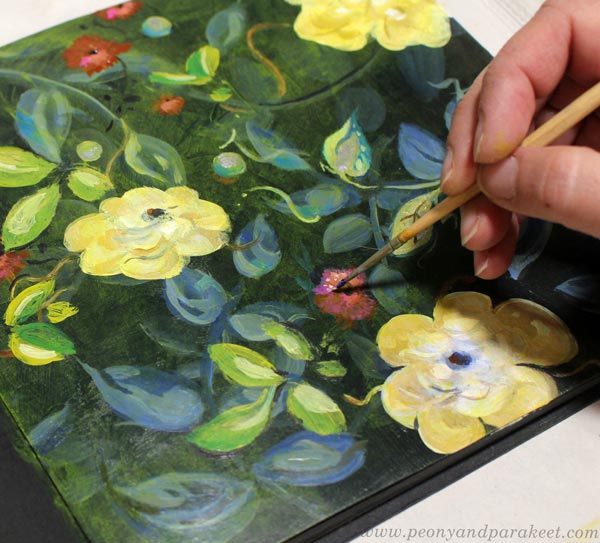
After the color wash, the painting is a bit hazy. Next, I added more details and brought some of them back up from the lower layers. This sharpens the best parts.

I had lots of tubes on the table but only used a few. Decorative painting encourages making a variety of tones by adjusting the lightness and darkness of color instead of always changing the actual color.
Happy for the Artist, Happy for the Viewer
There were moments of joy that only decorative painting can give me while making the page. This style feeds gentleness and peace. And even if the pleasures of the decorative painting process are only experienced by the painter, the decorative painting leads to results that are extrovertedly joyous, ready to brighten up anyone’s day.
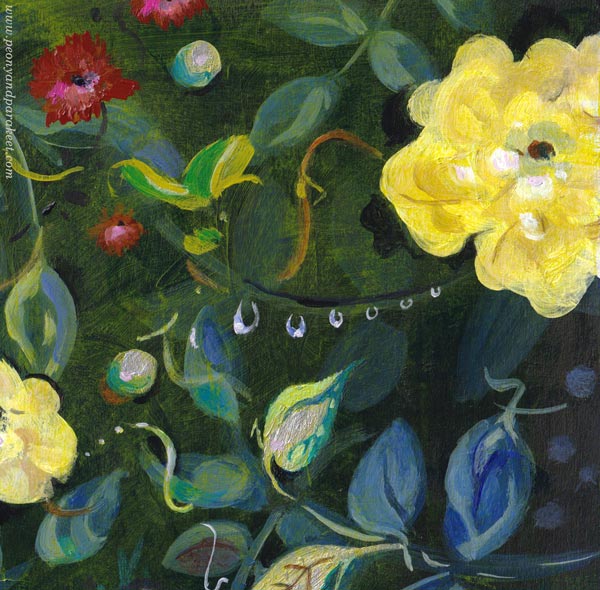
Decodashery online course – Paint vintage beauty – Buy Now!